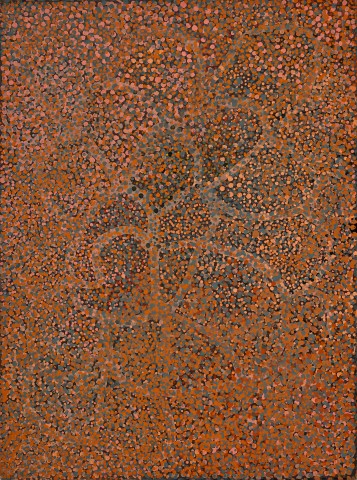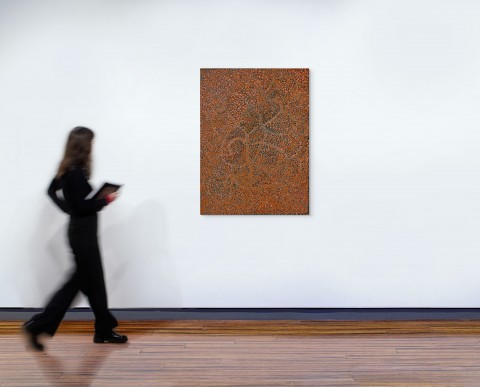UNTITLED (ENDUNGA), 1990
EMILY KAM KNGWARREYE
synthetic polymer paint on linen
121.0 x 90.5 cm
bears inscription verso: artist's name and Delmore Gallery cat. 0H19
Commissioned by Delmore Gallery, via Alice Springs, Northern Territory in 1990
Private collection, Alice Springs, Northern Territory
Sotheby's, Sydney, 9 November 1997, lot 130 (as ‘Edunga’)
Private collection, Melbourne
Sotheby's, Melbourne, 24 June 2002, lot 203 (as ‘Edunga’)
Private collection, Melbourne
Emily Kame Kngwarreye: Werke Australischer Privatsammlungen, Kunsthaus Zug, Zug, Switzerland, 1 October 2019 – 12 January 2020
Drury, N., Images 2 – Contemporary Australian Painting, Craftsman House, Sydney, 1994, p. 282, pl. 267 (illus.)
Voight, A., and Drury, N., Wisdom of the Earth – The Living Legacy of Aboriginal Dreamtime, Simon & Shuster, Sydney, 1997, p. 86 (illus.)
This work is accompanied by a certificate of authenticity from Delmore Gallery.
Deeply rooted in the Anmatyerr land of her ancestors to whom she paid respect through a lifetime of devotion to women’s ceremony in song, dance and the ceremonial painting of bodies, the art of Emily Kam Kngwarreye reveals a deep affinity to the country and the ever-changing desert landscape in her father and grandfather’s Country of Alhalker. As the youngest of three children, Kngwarreye chronicled on canvas this triangular-shaped country – the place she was born, and where she lived in the ways of the eastern Anmatyerr. The traditional life of the Anmatyerr and Alyawarr people was forever disrupted in the 1930s, when the borders of the Utopia pastoral lease were drawn across their lands. Over time, many local people including Kngwarreye found periodic work on the emergent pastoral stations. Sixty years later however, Kngwarreye was introduced to batik as part of adult education classes held on Utopia Station in 1977 and the following decade, in 1988‒89, Emily painted her first work on canvas, sparking a meteoric rise to fame.
Untitled (Endunga), 1990 is one of a small number of paintings of similar tonal colour produced in the second year of her painting that have come to symbolise her oeuvre. A masterpiece of strength and simplicity, the distinctive meandering linear pattern, based on the underground growth of the Atnulare yam, is infilled and overpainted with patterns of dotting that represents the fruit, seeds (Ntang) and reedy strands of the Endunga grass. Working from the periphery of the canvas, traceries and over-dotting spread energetically across the canvas limited only by the reach of the artist’s arm. ‘Kngwarray painted with great speed and intensity and the strength of her arms and hands…is apparent in the rhythmic, confident marks she made… echos of batik style and process are apparent in these early works on canvas.’1
Often domestic in theme, Kngwarreye’s painting demonstrates the interconnectedness of life, landscape and culture, a celebration of the seasonal variations in her homeland of Alhalker and the related spiritual and domestic obligations to country. When looking at this work, as Janet Holt states in the accompanying certificate, ‘One can imagine Kngwarray leaning forward, her digging stick nearby, her hands quickly rustling aside drying leaves and grasses seeking cracks in the ground indicating the presence of yams and their lineal connecting “strings” beneath the earth.’2
More than two decades have passed since Emily Kngwarreye died in September 1996, yet her name remains synonymous with the best of Australian Indigenous art. An original, intuitive and often enigmatic artist, her painting career lasted less than a decade, but the critical acclaim for her prodigious output has not diminished and her reputation has been sustained both in Australia and internationally.
1. Jenny Green, ‘The Life and Legacy of Emily Kam Kngwarray’ in Cole K., Green J., and Perkins H., (eds.) Emily Kam Kngwarray, National Gallery of Australia, Canberra, 2023, p. 157
2. From the accompanying Delmore Gallery certificate of authenticity.
CRISPIN GUTTERIDGE

